Stretching is an important component of any fitness routine. Although it can be tempting to finish a run, skip the stretches and go straight to the post-run burger, you know better. Stretching has many benefits, including increased range of motion and improved muscular coordination. Research shows that flexible muscles also recover more quickly because they are more receptive to glycogen replacement, which will fuel your next run. Even better: Your flexibility routine doesn't have to take a lot of time. Just five or 10 minutes is all you need at the end of your workout.
While any full-body stretching routine will do, there are some specific stretches for runners that can help improve your performance and prevent the aches and pains commonly associated with the sport.
Because running, while good for you in many ways, does put stress on your body—especially the lower limbs and joints—the following stretches target the muscles runners use most. Follow the short routine below if time is lacking, or ideally, add these running-specific stretches to your current flexibility training program, which should also include some general upper body and core stretches, too.
6 Important Stretches for Runners
The most important thing to remember is to only stretch warm muscles. Fitness experts recommend stretching after you work out; this is when your muscles are warm and your joints are lubricated, and therefore primed to stretch. While it's okay to stretch after your warm-up (but before
your
run), doing so might actually interrupt or negate the warm-up process, which is more likely to result in injury or problems. Unless specified, breathe deeply and hold each stretch for 15 to 30 seconds. Then, repeat on opposite side (if applicable). Perform each stretch once or twice, stretching only to the edge of discomfort—between a five and seven on a scale of one to 10.
Hamstring Stretch
Runners are notorious for tight hamstrings that can cause lower back problems and lead to pulled muscles. Tight hamstrings also limit your range of motion, which can affect running stride, form and speed. To improve hamstring flexibility, try this lying hamstring stretch, which keeps the spine neutral, whereas basic toe touches (forward bends) do not, thereby reducing risk of low back pain.
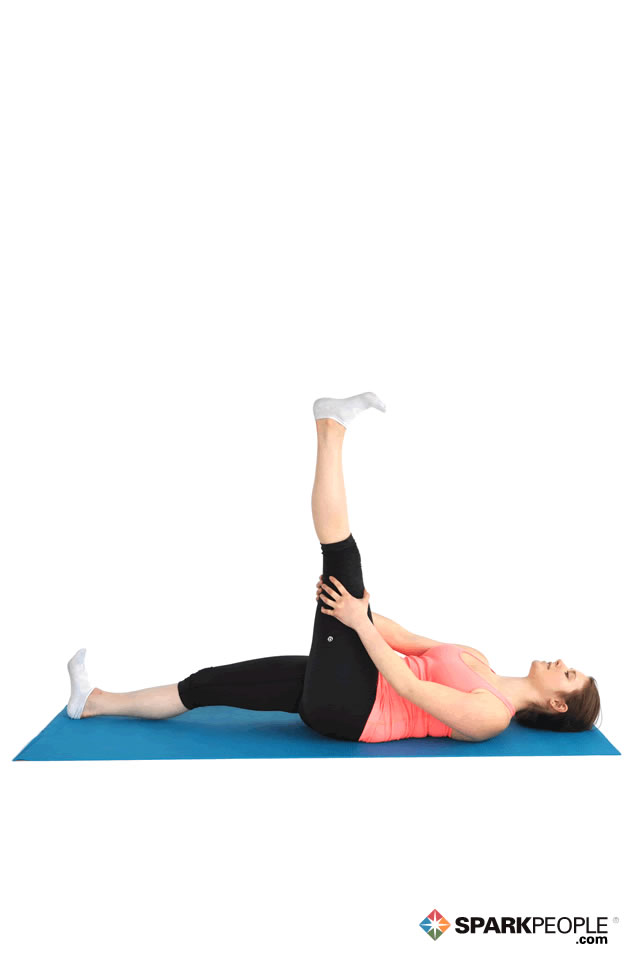 |
Lie on your back with your legs extended and your back straight. Keep your hips level and your lower back down on the floor. Bend your right knee towards your chest, keeping your left leg extended on the floor. Slowly straighten your right knee, grabbing the back of your leg with both hands. Pull your leg towards your gently while keeping both hips on the floor. Breathe deeply and hold for 10-30 seconds. Repeat on opposite side. To reduce the intensity of this stretch, bend the knee of the stretching leg. |
Quadriceps Stretch
Stretching the quads forces your hamstrings to contract, helping them get stronger. It's important to have strong and flexible quads since these muscles help lift your knees and increase your speed. This standing quad stretch is into to incorporate after a run, and once you master this, you can carefully pull your thigh and knee slightly behind your body (not pictured) for a greater hip flexor stretch at the same time.
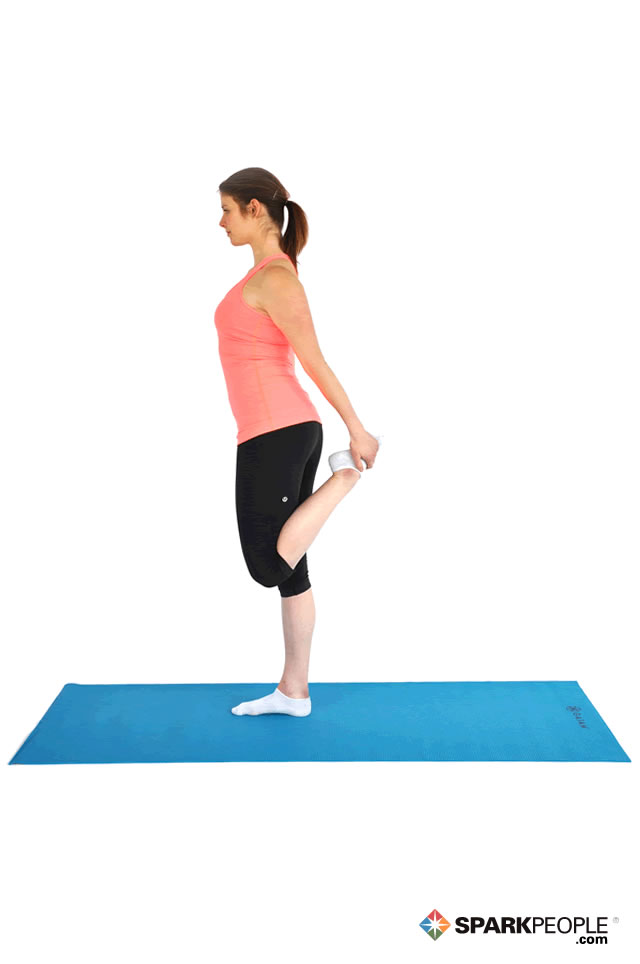 |
Stand tall, holding onto a chair or wall for balance if necessary (not pictured). Keep your feet hip-width apart, your back straight and your feet parallel. Reach back and grab your left foot with your left hand, keeping your thighs lined up next to each other and left leg in line with the hip (not pulled back behind you)
.
Breathe deeply and hold for 10-30 seconds. Repeat on opposite side. |
Piriformis
Stretches
Your
piriformis
muscle is responsible for the rotation of the hip. Although it's very important in activities that frequently change direction, it tends to tighten up in runners. If the
piriformis
becomes too tight or spasms, it can irritate the sciatic nerve, which causes pain in the glutes, lower back and thighs. To prevent these issues, try these two stretches:
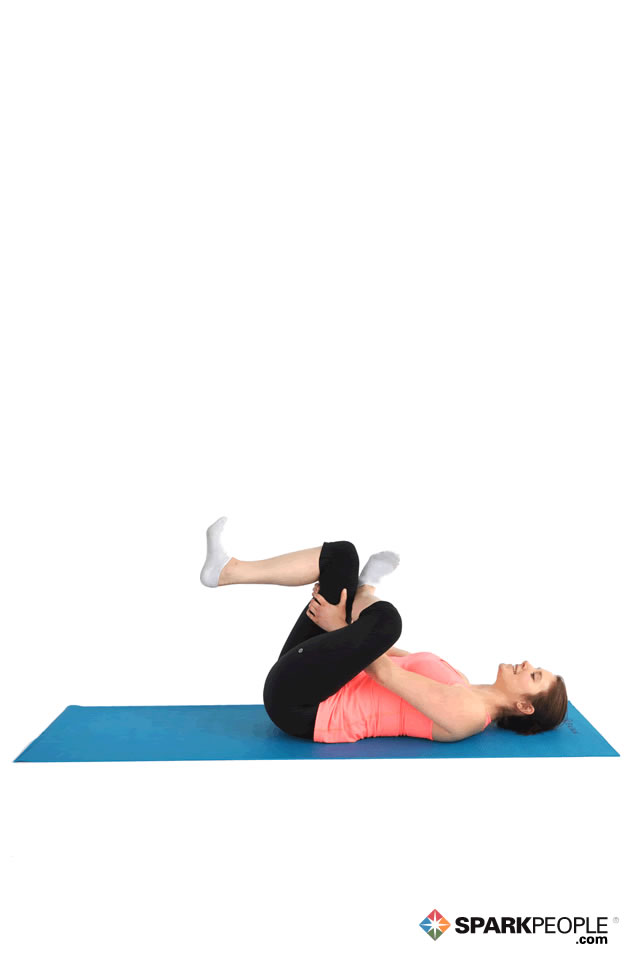 |
Lie on your back with your legs extended and your back straight. Keep your hips level and your lower back down on the floor. Bend your left knee, placing left foot flat on the floor (not pictured). Cross your right ankle
at
your left knee. Grab the back of your left thigh and hug your legs towards your chest. Place your right elbow on the inner portion of your right knee and push it slightly to the side. Breathe deeply and hold for 10-30 seconds. Repeat on opposite side. To reduce the intensity of this stretch, don’t bring your legs towards your chest as much. |
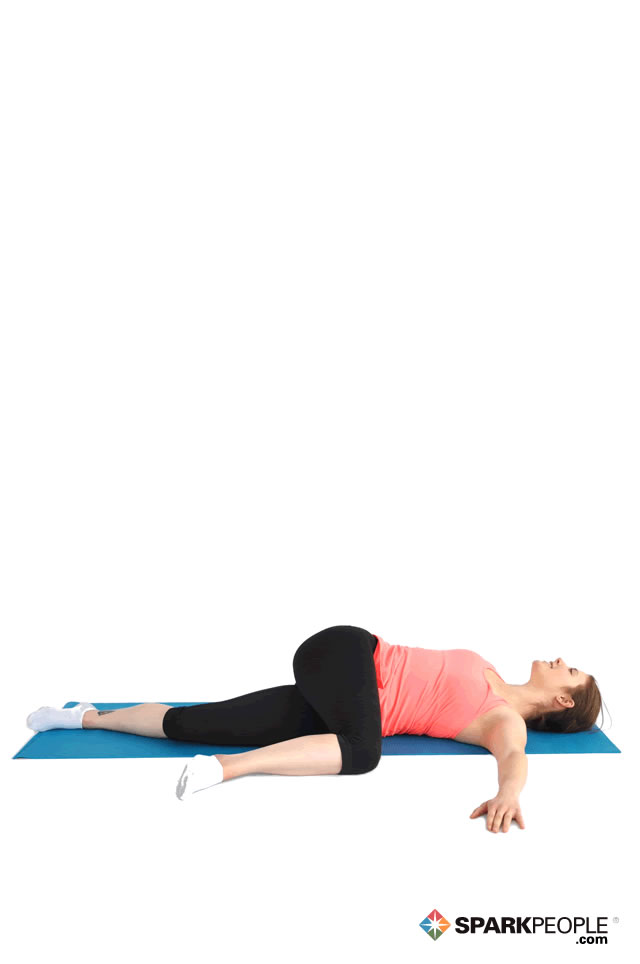 |
Lie on your back with your legs extended and your back straight. Keep your hips level and your lower back down on the floor. Bend your right knee towards your chest, grabbing it with your left hand. Place your right hand out to the side. Keeping your shoulder blades square (on the mat) use your left hand to guide your right knee across your body and towards the floor on your left side. Breathe deeply and hold for 10-30 seconds. Repeat on opposite side. Don’t force your knee to the floor if your flexibility does not allow it. |
Calf Stretch
Flexible calf muscles can improve your ability to increase the length of your stride, which results in increased speed. Loose calf muscles also take some of the burden away from your
shins
as you bring your trailing leg forward when running, helping prevent shin pain or shin splints. This basic calf stretch is an easy one to incorporate.
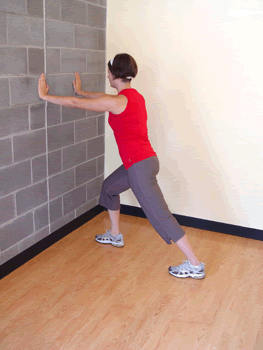 |
Stand facing a wall, about 12 inches away from it. Extend your arms in front of your shoulders to place your hands flat on the wall, keeping the elbows bent. Keeping both feet flat, step or slide your left foot (pictured) back, lengthening your left leg and straightening your arms. You should feel the stretch in the calf of the back (straight) leg. The more
your
lower your heel to the floor, and the farther you slide your straight leg behind you, the deeper you will feel this stretch. Breathe deeply and hold for 10-30 seconds. Switch sides. |
Iliotibial (IT) Band Stretch
The
illiotibial
band is part of a muscle that runs along the outside of the knee and can create pain when it starts to rub on the kneecap. This is typically an overuse injury (trying to do too much too soon or not giving your body adequate time for rest and recovery). Stretches that target the IT band, like the example below, can reduce pain and prevent future knee problems.
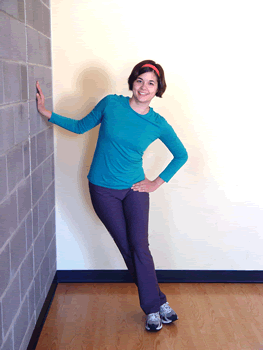 |
With the left side of your body next to a wall, stand tall with your hand on the wall and your body an arm"s length away from the wall. Cross your right leg (leg farthest from the wall) in front of your left leg (leg closest to the wall) and place your opposite hand on your hip, shoulders relaxed, feet flat on the floor. Breathe slowly and steadily as you push your left hip toward the wall, bending your left elbow. Keep the foot closest to the wall flat on the floor, both legs straight, and your back straight (no leaning forward or back). Hold the stretch for 10-30 seconds. Switch sides. |
Try these stretches specifically for
runner
after cooling down, and see if it makes a difference in your running performance and progress. It doesn't take long to notice improvements in flexibility, so take the time to stretch and your running legs will thank you for it! |












.jpg)

